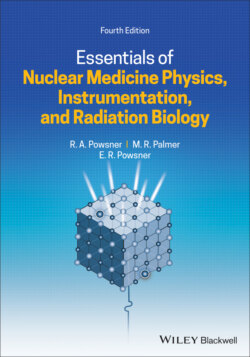Читать книгу Essentials of Nuclear Medicine Physics, Instrumentation, and Radiation Biology - Rachel A. Powsner - Страница 19
Representation of electron distribution:
ОглавлениеMost of the diagrams (for example Figure 1.6) in this chapter reflect what is referred to as the Bohr model of the atom and as such all electrons within each shell are depicted as moving along the surface of a sphere, each shell represented as one such sphere with a distinct radial distance from a centrally located nucleus. The radius of these spheres increases with principal quantum number. This model of the atom is frequently used for teaching purposes because the radial distance of an electron from the nucleus is used to depict with how tightly bound it is to the atom—the closest electrons being most tightly bound.
A more accurate quantum mechanical description of electron distribution uses a sequence of orbitals. Orbitals are mathematical functions that describe the probability of finding an electron in a region of space near the nucleus. For each principal quantum number (each shell) there is a spherical orbital denoted by the principal quantum number followed by the letter “s”. This orbital contains two electrons (Figure 1.7a). This is the only orbital for the K shell which contains at maximum two electrons and this orbital is called the 1s orbital. The neutral atom with a full K shell is the helium atom.
The next shell, the L shell (n = 2), also has a spherical orbital, denoted 2s (also depicted as Figure 1.7a) which contains two electrons, as well as three sub‐orbitals, denoted 2px, 2py, 2pz. Each sub‐orbital has a shape like a dumb‐bell or three‐dimensional figure eight (see Figure 1.7b). The three sub‐orbitals are oriented along three orthogonal axes as shown in Figure 1.7c. Each sub‐orbital is filled by two electrons and the neutral atom with completely filled orbitals for n = 1 and n = 2 is Neon.
For the higher order orbitals, n > 2, the sub‐orbitals associated with higher azimuthal quantum number become even more complicated in structure and will not be discussed here.
